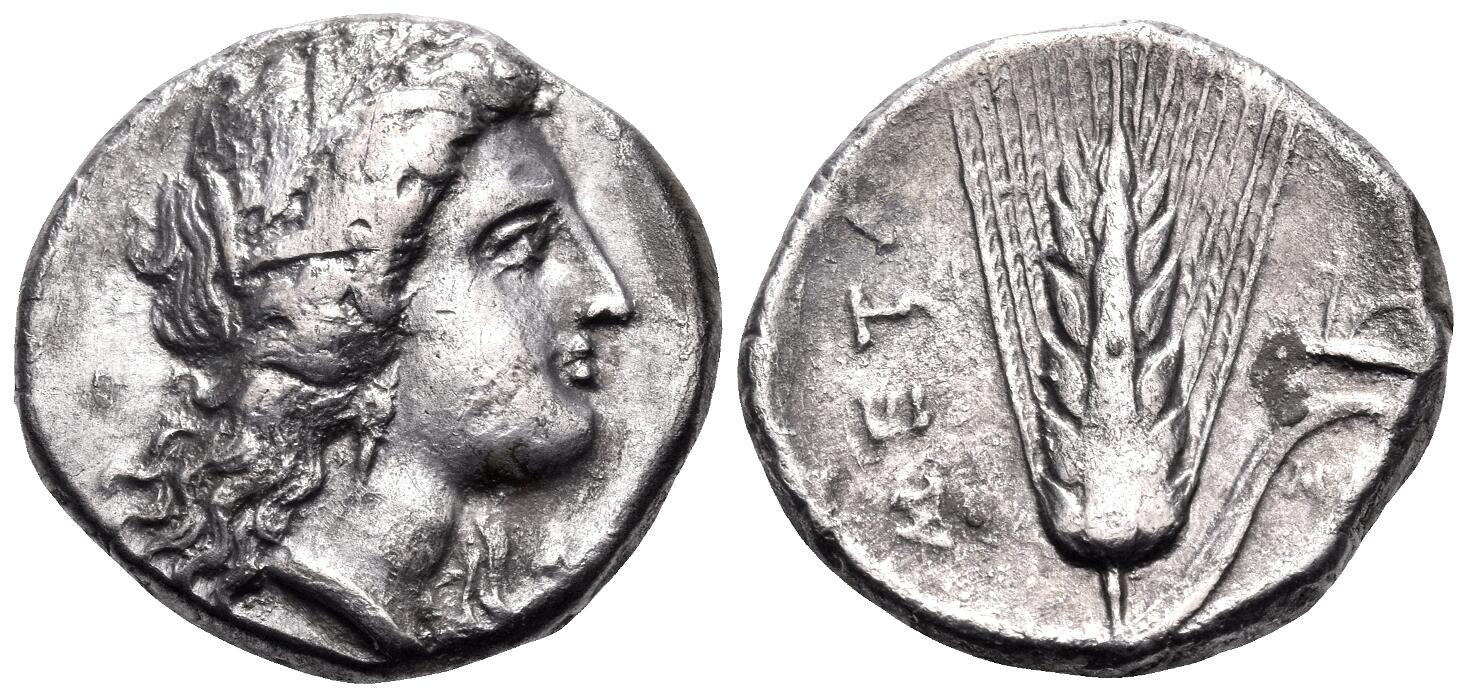Metapontum, silver, nomoi (330-280 BCE): Difference between revisions
From SILVER
No edit summary |
No edit summary |
||
| Line 29: | Line 29: | ||
|Frequency=2 | |Frequency=2 | ||
|Number of dies=44 | |Number of dies=44 | ||
|Die name=B2.4;B2.11;B2.14;B2.17;B2.19;B2.21;B2.23;B3.1;B3.3;B3.20;B3.23;B4.1;C1.5;C1.7;C1.34;C1.53;C1.66;C1.68;C3.1;C4.7;C4.9;C4.11;C4.16;C5.8;C5.10;C6.13;C6.15;C7.1;C7.3;C7.5;C8.1;C8.14;C8.17;C9.2;C10.1;C10.3;C11.1;C11.3;D2.3;D2.6;D4.4;D4.11;D4.13;D5.3 | |||
}} | }} | ||
{{Distribution Item | {{Distribution Item | ||
Revision as of 20:01, 9 November 2022
330 BCE - 280 BCE Silver 31,496 kg
Description
| ObverseInscription or printing placed on the obverse.: | Various heads. Head of Demeter to right, wearing wreath of barley ears and triple-pendant earring |
| ReverseInscription or printing placed on the reverse.: | META (Greek).Ear of barley, with leaf to right, above leaf, plough to right |
Mint and issuing power
| MintIdentifies the place of manufacture or issue of a numismatic object.: | Metapontum | Ancient regionAncient region.: | Lucania | Modern countryModern country: Italy | AuthorityIdentifies the issuing power. The authority can be "pretended" when the name or the portrait of X is on the coin but he/she was not the issuing power. It can also be "uncertain" when there is no mention of X on the coin but he/she was the issuing power according to the historical sources: |
Chronology
| FromIdentifies the initial date in a range assigned in a numismatic context. | 330 BCE | toIdentifies the final date in a range assigned in a numismatic context.. | 280 BCE | PeriodTime period of the numismatic object.: Hellenistic 323-30 BC |
Physical description
| MetalThe physical material (usually metal) from which an object is made.: | Silver |
Median weightMedian of the weights of numismatic objects (in grams). in grams | 7.90 | DenominationTerm indicating the value of a numismatic object. Examples: tetradrachm, chalkous, denarius.: | didrachm |
StandardStandard.: |
Image

RQEMH 5 - Metapontum, silver, stater, 330-280 BC.jpg [1]
References
| Die study referencePublication of the study: | Johnston 19901Johnston 1990 | ||
| Coin series referenceReference to coin series study: | |||
Obverse dies distribution
Reverse dies distribution
no distribution is available
Quantification
| Number of obversesNumber of obverse dies. ᵖ (o) | 135 | Number of singletons (o1)The number of singleton coins. ᵖ | 44 |
| Number of reverse diesNumber of reverse dies. (r) | NC"NC" is not a number. | Number of coinsNumber of coins. (n) | 307 |
| Coins per obverse dieNumber of coins per obverse die. (n/o) | 2.27 | Coins per reverse dieNumber of coins per reverse die. (n/r) | |
| Reverse per obverse ratioRatio of obverse dies divided by reverse dies. (r/o) | Percentage of singletons (o1)number of coins (n) divided by the number of singletons (o1) ᵖ | 32.59 % | |
| Original number of dies (O) (Carter 1983 formula)The estimation of the number of coins according to Carter 1983 ᵖ | 199.34 | Coins struck if 20,000 as average productivity per dieCoins made if the average productivity for obverses (according to Carter) is 20,000. ᵖ | 3,986,800 |
| Original number of dies (O) (Esty 2011 formula)The estimation of the number of coins according to the singleton formula in Esty 2011 ᵖ (O) | 240.96 | Survival rate if 20,000 as average productivity per dieSurvival rate if average productivity is 20,000. ᵖ | 0.00008 |
| Coverage (o = % of O) (Esty 1984 formula)Esty 1984 - coverage (% of O) ᵖ (o = % of O) | 85.67% | Die productivity if survival rate 1/2,000Average productivity if survival rate is 1/2,000. ᵖ | 3,080.16 |
| Weight of silver (in kg) if 20,000 coins per die (O = Carter formula)Carter 1983 * Median weight * 20000 (*10 if gold or electrum) ᵖ | 31,496 kg <br /> 31,496 kg | Die productivity if survival rate 1/5,000Average productivity if survival rate is 1/5,000. ᵖ | 7,700.41 |
Remarks
References
- ^ Johnston, Ann (1990), The Coinage of Metapontum. Part 3, Numismatic Notes and Monographs, 164, New York.